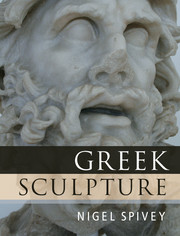Book contents
- Frontmatter
- Dedication
- Contents
- List Of Figures
- Preface
- Note
- 1 Introduction: the Study Of Greek Sculpture
- 2 The Greek Revolution
- 3 Daedalus and the Wings of Technê
- 4 Anathêmata: Gifts for the Gods
- 5 Heroes Apparent
- 6 Temple Stories
- 7 In Search of Pheidias
- 8 Revealing Aphrodite
- 9 Royal Patronage
- 10 Portraits and Personifications
- 11 Graecia Capta
- 12 Afterlife
- Index
6 - Temple Stories
Published online by Cambridge University Press: 01 December 2014
- Frontmatter
- Dedication
- Contents
- List Of Figures
- Preface
- Note
- 1 Introduction: the Study Of Greek Sculpture
- 2 The Greek Revolution
- 3 Daedalus and the Wings of Technê
- 4 Anathêmata: Gifts for the Gods
- 5 Heroes Apparent
- 6 Temple Stories
- 7 In Search of Pheidias
- 8 Revealing Aphrodite
- 9 Royal Patronage
- 10 Portraits and Personifications
- 11 Graecia Capta
- 12 Afterlife
- Index
Summary
No ancient author cares to tell us why Greek temples were decorated the way they were. We know that the construction of a temple was a major political and financial commitment: we may suppose that the embellishment of a temple gave ‘added value’ to an already valuable edifice – enhancing a sense of indebtedness between those dedicating the temple and the divinities in whose honour it was dedicated. What else is to be expected? Some sort of religious instruction, presumably: some visual statement of what was intended as the ritual and spiritual function of the building. Subsequently this sacramental element might be encompassed (in Christian parlance) by the term ‘liturgy’, which transliterates a Greek word for ‘public duty’ (leitourgia); but it is not clear whether temple decoration was so specifically prescriptive as to instruct worshippers on their actual conduct within the sacred precinct (temenos) – or to provide, as one scholar phrases it, ‘prayers in stone’. (Still less is it clear that such decoration served as if ‘scripture for the illiterate’.) Rather, images were evocative of the cosmological, mythical and historical reasons for ritual, and veneration of the gods. Images set the scene: images articulated local and Panhellenic systems of praise and shame, heroism and cowardice, virtue and wrongdoing. And it was in the nature of Greek imagery to generalize not only the rules of these systems, but also their application.
An excerpt from a brief but deeply influential Aristotelian text, the Poetics, justifies this practice. Aristotle is discussing literary media; but what he says about ‘poetry’ is transferable to ‘art’.
The poet's function is to describe not the thing that has happened, but a kind of thing that might happen, i.e. what is possible as being probable or necessary. The distinction between historian and poet is not in the one writing prose and the other verse – you might put the work of Herodotus into verse, and it would still be a species of history; it consists really in this, that the one describes the thing that has been, and the other a kind of thing that might be. Hence poetry is something more philosophic and of graver import than history, since its statements are of the nature rather of universals, whereas those of history are singulars.
POETICS 1451B, TRANS. BYWATER- Type
- Chapter
- Information
- Greek Sculpture , pp. 150 - 173Publisher: Cambridge University PressPrint publication year: 2013



